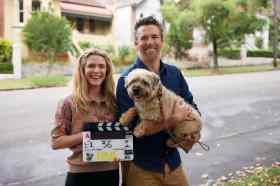Six-year-old Hushpuppy lives in an isolated bayou called the Bathtub, cut off from the rest of the world by a vast, encircling levee. She lives with her father, but she has her own house, and he has his. Both houses are more like elevated junk-yards on stilts, jerry-built from whatever materials they could scavenge from the bayou.
The same goes for the rest of the community in the Bathtub; houses and bars and the corner store all look like left over sets from a Cajun-style Mad Max. It is partly because of this retro-futurist, apocalyptic art design that the film evinces an ambience of ‘fantastic realism’ throughout.
The community in the Bathtub is a close one, and they seem to take every opportunity to celebrate their community with spontaneous parties filled with wild Cajun music, mad percussion, lots of beer and wacky costumes. It looks like it is pretty hot in the bayou, so everybody needs some party time to let off steam and allow themselves to be the ‘beasts’ that they are.
In a key scene that serves to explain (at least partly) the title of the film, a friend of Hushpuppy’s father tries to show her how to open a cooked crab by using a knife. Hushpuppy’s father, Wink, explodes with fury, exclaiming that they don’t eat like that – they eat like beasts. With that, Hushpuppy and her children friends all tear into the cooked crabs with their bare hands and teeth, while the adults around them drunkenly chant, ‘Beast it! Beast it! Beast it!’
But it is not all beer and skittles in the Bathtub. Hushpuppy’s father mysteriously collapses one day, and Hushpuppy, finding him prostrate, thinks he is dead (and so do we). He is not dead, but when he recovers, his attitude towards Hushpuppy has changed: he is more secretive, more likely to explode in anger for no apparent reason. Shortly after this he disappears completely. What is the explanation for all this? Hushpuppy is baffled, and it is part of the charm of this film that we, the audience, are so effortlessly made one with Hushpuppy’s view of things that her confusion and defiance in the face of the mysteries of her world become ours as well.
When her father returns, it is with a warning that a storm is approaching.
It is at this point in the film that the various themes that have been subtly evoked begin to intertwine. For not only is a huge, dark, hurricane of a storm approaching the Bathtub, but the giant aurochs are coming too.
In the community classroom, Hushpuppy and her classmates are shown a tattoo on the thigh of their teacher, Miss Bathsheba. She tells them that it is an image of the extinct auroch, a huge, hairy beast with gigantic tusks. Hushpuppy dreams that night that the aurochs, frozen within the ice of the Arctic Circle, are catastrophically released as the ice shelves at the pole begin to calve and fracture. A monstrous herd of the beasts are trampling their way towards the Bathtub.
Wink tries to scare off the approaching storm by firing his rifle into the night sky, but the storm comes anyway… and so do the aurochs.
When her entire community is flooded, and the survivors try to reconstruct some semblance of beasthood, Hushpuppy and some of her children friends hail a passing boat, and Hushpuppy goes off in search of her missing mother who left her and Wink years ago. They arrive at what appears to be a floating saloon, and once inside, Hushpuppy thinks she has found her mother amongst the dancing girls and hostesses.
All of these unlikely scenes follow each other effortlessly. Each scene is half-real, half-fantastic, and we are never sure whether Hushpuppy’s/our view of things is how things really are, or whether we are just in the grip of our powerful six-year-old imagination.
This is very accomplished filmmaking from a director who has never made a feature film before. Part of the charm of Beasts of the Southern Wild is, I think, the palpable sense of excitement that fills every frame: the restless handheld camera-work; the assured, unhurried editing; the otherworldly strangeness of the bayou and levee; and the oftentimes superb performances from the cast, all of whom (evidently) have never acted before. The excitement also comes from the fact that the film was made with a very small crew on a limited budget, inflected with a use-whatever-is-at-hand attitude that makes the world they are creating seem so alive – electric, even.
Six-year-old Quvenzhané Wallis – who last week became the youngest-ever actor to be nominated for an Academy Award for her role in the film – is totally convincing as the strong-willed Hushpuppy, and she is matched by a powerful performance by Dwight Henry as her father, Wink. Henry runs a bakery in his non-Beasts life, and the director’s Fellini-esque decision to cast non-actors certainly paid off when Henry was convinced to leave the bakery for a few weeks.
There is a palpable mythic quality to Beasts of the Southern Wild, which reminded me of the work of British writer Alan Garner, particularly his Stone Quartet. If you are not familiar with his work, no matter, this film can definitely stand on its own two (or is it four?) feet without any high-falutin’ references from me.
If you liked Spike Jonze’s version of Where the Wild Things Are, you should definitely see this – it is much, much better. And if you didn’t like Where the Wild Things Are – see this: it’s what you were hoping to find when you wanted your child’s view of the fantastical apocalypse fix.
Rating: 5 stars out of 5
Beasts of the Southern Wild
Directed by Benh Zeitlin
USA, 2012, 93 mins
Available on DVD and Blu-ray from 18 January
Icon Film Distribution
Rated M
Actors:
Director:
Format:
Country:
Release:





